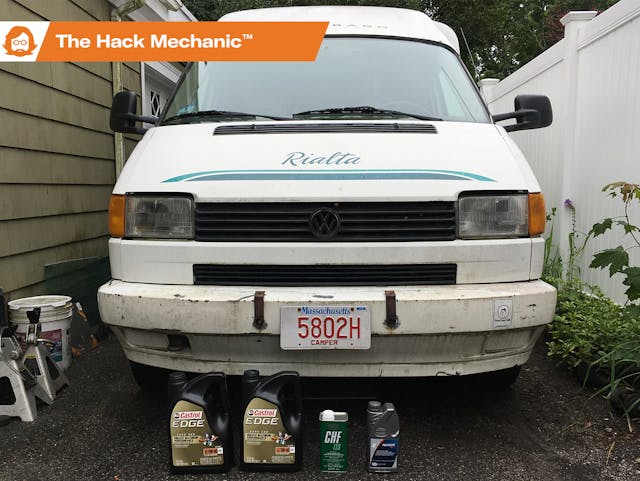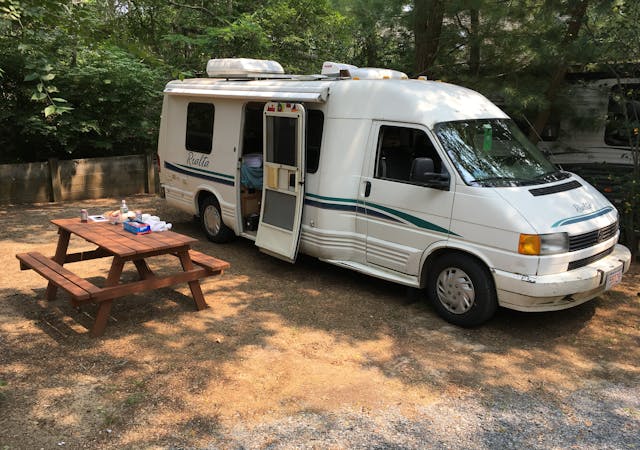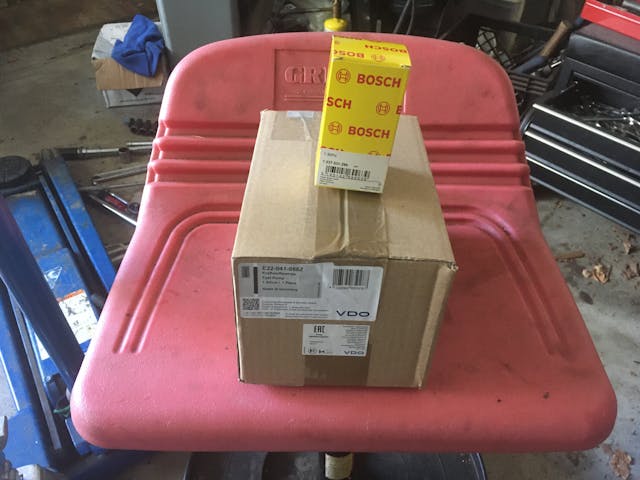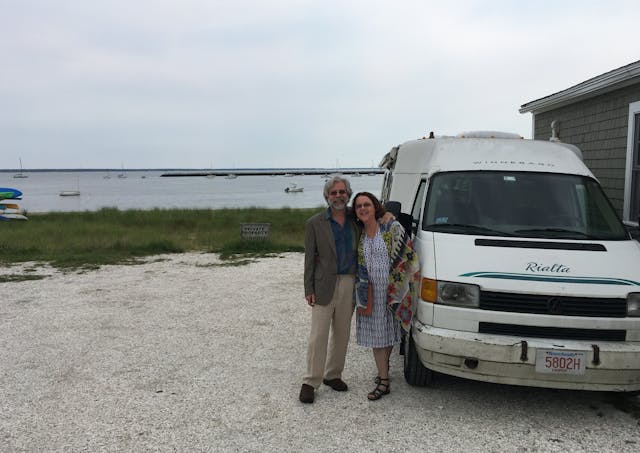Media | Articles
Chasing reliability, Part 2: Preventive maintenance

Last week, I talked about reliability issues in two very different cars in my arsenal—the 2003 BMW E39 530 stick sport that’s ostensibly my daily driver, and my 1996 Winnebago Rialta (a Volkswagen Eurovan with a Winnebago camper body) that my wife and I use for short trips to the Cape. I described addressing some maintenance issues in the Rialta, including ball joint replacement and new tires, and put forth the general theory that while cars—particularly older ones—can die at any time, the causes are usually common ones, and what makes you really feel like an idiot is when you ignore a known problem and then have that very problem be the cause of an inconvenient and expensive stranding.
Then, I left you with “to be continued …” Shortly before our trip, the Rialta began suffering no-starts in wet weather. I diagnosed a cracked ignition coil pack as what appeared to be the cause, but also learned that these vehicles suffer a warm-running “sudden death syndrome” that implicates the fuel pump and the pulse module inside the distributor. I drove five hours round trip (in another car) to FCP Euro near New Haven, Connecticut, to grab an OEM coil pack, as well as an OEM fuel pump and pulse module. I installed the new coil pack, sprayed it with a hose, and verified that it appeared to solve the wet-starting problem. I did not install the new pulse module and the fuel pump, but I staged them with the tools and other spares as I packed the Rialta to drive to Provincetown for a mini-vacation with my wife.
But first, I finished up some fluid-related issues. Like many modern vehicles, there’s no dipstick on the Rialta / Eurovan to check the transmission fluid level. Instead, you need to start it, warm it to between 35–45°C as measured with an infrared thermometer, open the drain port, and verify that fluid just weeps out. In addition, the previous owner had the oil changed before I bought the rig four years ago, but I couldn’t find records whether she’d used synthetic or dino.
Our 10 short trips in the rig hadn’t even added 3000 miles, but I opted for draining it and filling with synthetic. Unfortunately, I found that the oil drain plug needed a 14mm Allen key. I was sure that I had one somewhere but couldn’t locate it. I was able to find a 14mm nut that was tall enough to both sit in the drain plug as well as have enough relief for a 14mm box-end wrench to get a bite on it.

Regarding the trip, I’ll end the suspense. We made it to P-town and back just fine. Absolutely nothing went wrong. The little RV positively exuded an aura of reliability, possibly created by the correctly oscillating magnetic and electric fields generated by the coil pack itself, reinforced by the presence of that spare fuel pump and pulse module. Granted, this was just a little three-day 250-mile jaunt, not a big western road trip, but a lot of work went into it, and it was immensely satisfying.
Marketplace
Buy and sell classics with confidence

Theoretically, I could’ve said all this last week, but a) it hadn’t happened yet, and b) I’d like to wrap it up with some additional thoughts on preventive maintenance, including why I decided not to install the just-purchased pulse module and fuel pump.
I routinely recite “The Big Seven” (TBS) things likely to cause you and your older car to go from livin’ the dream to dead in the breakdown lane searching for a signal on your cell phone. I list them as fuel delivery, ignition, cooling, charging, belts, clutch hydraulics, and ball joints, with tires being item #0, as flats are so common that nearly every car includes a spare … and no one says, “A spare what?”
In addition to TBS, many enthusiast vehicles have known weak points that can be learned about via a FAQ on a dedicated user forum. On the Rialta, these are the rear wheel bearings and the need for a transmission cooler, both of which are weaknesses inherited from the fact that the Rialta’s 7000-pound bulk is constructed on a much lighter Volkswagen Eurovan platform. These are both on my to-do list. I’ve found that the left rear wheel bearing is just starting to rumble, and I wouldn’t even consider subjecting the rig’s little Eurovan transaxle to a real road trip with a long hill climb without a transmission cooler.
To be clear, there are many things other than TBS that can go wrong on an older car, but they tend to degrade slowly and give lots of warning or are unlikely to cause the car to actually become undrivable, or both. For example, brake pads wear down and then screech when the metal on the pad hits the metal on the rotor. Exhaust holes begin as pinholes and widen, gradually growing louder. But a popped coolant hose or a broken belt can strand in a heartbeat and can often be easily avoided by simply checking for soft hoses and a cracked belt before a trip. Fuel pumps are a little trickier, as they can die with little or no warning, so replacement of a pump at the first sign of trouble is smart, and prophylactic replacement of a very old or very high-mileage pump before a long trip isn’t a bad idea.
So why, after driving to Connecticut and spending $167 on an OEM fuel pump and $65 for a pulse module for the Rialta, didn’t I install both of them prophylactically?
Well, part of it was that neither installation is trivial. Replacing the pulse module is a benchtop process that requires the distributor to be removed from the car. Accessing the in-tank fuel pump requires removal of the driver’s seat and the handbrake surround and peeling back the carpet. Yes, both of these things are better done in your driveway than by the side of the road, but with only 110,000 miles on the Rialta and no clear evidence that there was a problem with either item, I left them alone.
Then why did ol’ penny-pinching me drop $232 on a new fuel pump and pulse module? Because I couldn’t afford to be wrong about my coil pack diagnosis, and these were the next two likely culprits. Plus, I figured, if the Rialta did die and need to be towed somewhere for repair, the process could be expedited by having the parts with me, and I’d have high-quality OEM parts, not just whatever a shop could get.
At this juncture, I need to stop and tell you the story about the British analysis of artillery damage to aircraft in WWII. They wanted to armor the aircraft to better withstand the enemy guns. They began to do what seemed reasonable—to install armor on the areas where there were the most bullet holes. But then, Hungarian-born mathematician Abraham Wald recommended that planes with holes in those areas had, in fact, made it back safely, so damage in those areas must not be critical. Instead, he recommended that they should armor the areas without bullet holes, because planes with holes in those areas weren’t making it back. It’s a brilliant and often-cited example of counterintuitive reasoning.
I bring this up because, in the dynamic of preventive maintenance on “The Big Seven,” it certainly is possible to take it too far and replace good functioning original parts with something inferior. It’s easy to do this if you hop on eBay or Amazon and buy the lowest-priced part that’s listed as compatible with your make and model. The surprising and unfortunate thing is that it’s also possible to do even if you stick with what you believe to be high-quality parts.
I wrote a piece for Hagerty a few years back detailing what you need to know about replacement parts. The short form is that Original Equipment (OE), or “genuine” parts, are those you buy at the dealer and should, in theory, be identical to those that originally came on the car. Original Equipment Manufacturer (OEM) parts are those made by whatever vendor the dealer actually contracts with. And “aftermarket” parts are those produced by someone other than the OEM.
The problem is that these things don’t remain static. The manufacturer / dealer network may initially have an ample supply of original parts for a certain model, but as that model ages and there are fewer of them on the road, the manufacturer / dealer’s priorities swing away from older cars in favor of parts for newer models still under warranty. They may change the OE supplier from Company A to Company B. Or they may continue to use Company A, but Company A may subcontract the manufacture of the part out to a low-cost bidder. Or both Company A and Company B may be purchased by Company C who then produces one part and sells it under both labels. I and others have written repeatedly about how the quality of most new OE/OEM condensers used in old-school points-and-condenser ignition systems is just horrible, with new Bosch condensers purchased at the BMW dealer in BMW boxes with BMW part numbers lasting just five miles.
In the case of the fuel pump, there’s a lot of similarity between the E39 BMW and the Rialta / Eurovan. Both have an in-tank fuel pump assembly where the electric motor (the “insert,” as it’s sometimes called) is hung from the screw-in tank flange and surrounded by a plastic cradle and a float-level sensor. With both, you can replace the entire assembly, or only the “insert”—although, on the Riata, it turns out that the part that threads into the top of the tank has to be reused, as it contains an extra nipple to feed gas to the Rialta’s onboard 110VAC generator. With both, the OE fuel pump supplier appears to have been Pierburg, which is now owned by TI Automotive. Pierburg fuel pumps are distributed in the United States by the automotive giant Hella, and as such are sometimes branded as Pierburg, sometimes as Hella. So the box may say Pierburg, Hella, or TI Automotive.
However—and here’s the application of the armoring analogy—I found reports attributing the cause of the Rialta / Eurovan’s “sudden death syndrome” to a faulty internal overload sensor inside a recently-replaced OEM Pierburg fuel pump, along with a recommendation that folks not prophylactically replace a correctly-operating fuel pump. For this reason, not only didn’t I replace the Rialta’s fuel pump, I elected to buy a VDO fuel pump instead of a Pierburg, for which I didn’t see any reference to the overload issue. VDO is an OEM to Volkswagen, just not for the fuel pump. It’s entirely possible that, due to the hydra-like nature of the corporate world, VDO is part of the TI / Pierburg / Hella chain, and the VDO fuel pump is identical to the Pierburg / Hella, but I could find nothing online documenting it.
On the E39 BMW, because the car did suffer an afternoon-long, fuel-related die-and-resurrection episode, and because the car has 200,000 miles on it, I did opt to replace the fuel pump. I bought a Pierburg pump insert, but only after not seeing any overload issues in the BMW world, and wading through considerable confusion regarding two slightly different models—one of which is a drop-in replacement, the other of which requires modification.
The funny part is that, after we got back from our three-day trip in the RV, I found both the VDO fuel pump and the spare pulse module sitting on the work stool in the garage. I forgot to pack them. Apparently, their reliability-aura-inducing capability is so strong that it could project 125 miles across Cape Cod Bay.

I take that back. That’s not the funny part. The funny part is that part of my justification of the little RV is that we can stay in close-to-the-beach campgrounds that cost $30–$70 a night. Here’s what it cost to prepare for this two-night stay:
I like adding up costs like this because, as I’ve said before, with 12 vehicles, none of them ever get everything they need, and when spending on one of them spikes, it helps me understand why and helps to make decisions. Still, I don’t bat an eyelash at this or at the other RV expenses to come. The Rialta was cheap when I bought it four years ago, we enjoy using it, we’re keeping it, and this is reasonable cost for long-delayed maintenance.

***
Rob Siegel’s new book, The Best Of The Hack MechanicTM: 35 years of hacks, kluges, and assorted automotive mayhem, is available on Amazon. His other seven books are available here, or you can order personally-inscribed copies through his website, www.robsiegel.com.














